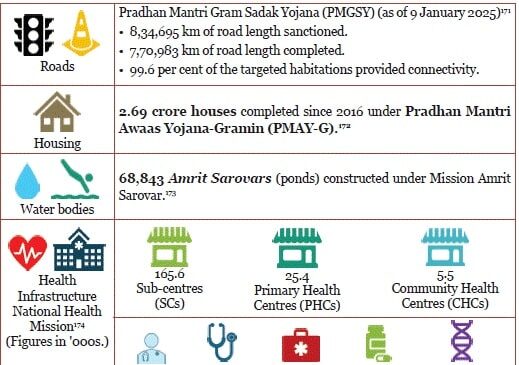Vision for Rural Development: Viksit Bharat 2047

The Indian government has set an ambitious goal for the future: a ‘Viksit Bharat 2047’. This vision emphasizes the principle of ‘Sabka Saath, Sabka Vikas’, which translates to ‘Together with All, Development for All’. The aim is to enhance the quality of life and ensure equitable development, particularly in rural areas. The Economic Survey 2024-25, presented by Union Minister for Finance and Corporate Affairs, Smt. Nirmala Sitharaman, outlines a comprehensive ‘Welfare for All’ approach. This strategy is rooted in a ‘Whole of Government’ framework, focusing on various sectors to uplift rural communities.
Enhancing Rural Infrastructure
One of the key areas of focus in the government’s rural development agenda is infrastructure. Significant measures have been taken to improve rural housing, drinking water, health and sanitation, clean fuel, and connectivity. The Economic Survey highlights the importance of digitization and technology in transforming the rural economy. This includes advancements in agricultural practices and governance.
A notable initiative is the special emphasis on infrastructure development in Particularly Vulnerable Tribal Group (PVTG) areas. Under the Pradhan Mantri Gram Sadak Yojana (PMGSY), a new vertical has been introduced to enhance connectivity to unconnected PVTG habitations. The government aims to construct a total of 8,000 kilometers of roads under this initiative. This effort is crucial for ensuring that marginalized communities have access to essential services and opportunities.
Moreover, the government is also focusing on improving rural housing. The construction of homes is not just about providing shelter; it also generates employment. Each house built under the Pradhan Mantri Awaas Yojana-Gramin (PMAY-G) creates approximately 314 person-days of work. This includes skilled, semi-skilled, and unskilled labor. Since 2016, 2.69 crore houses have been completed, significantly contributing to rural employment and economic growth.
Localizing Sustainable Development Goals
The Economic Survey emphasizes the localization of Sustainable Development Goals (SDGs) to ensure that rural development aligns with global objectives. This approach addresses fundamental needs such as housing, sanitation, water supply, and electrification. The government’s vision of ‘Sabka Saath, Sabka Vikas’ and the goal of a Viksit Bharat by 2047 provide a roadmap for achieving these SDGs.
A ‘whole-of-the-government’ strategy is being implemented, promoting cooperative and competitive federalism among states. This collaborative approach ensures that resources are utilized effectively and that rural development initiatives are tailored to local needs. By aligning national policies with global goals, the government aims to create a sustainable and inclusive environment for rural communities.
Enhancing Rural Incomes and Livelihoods
The Economic Survey outlines several reforms aimed at enhancing rural incomes and livelihoods. The Mahatma Gandhi National Rural Employment Guarantee Scheme (MGNREGS) has been optimized to ensure transparency and efficiency. Measures such as geotagging and direct bank transfers have been implemented to eliminate leakages and ensure timely wage payments. As of December 2024, 99.98% of payments were processed through the National Electronic Fund Management System, with a significant percentage of transactions facilitated by the Aadhaar Payment Bridge System.
Additionally, the Deendayal Antyodaya Yojana – National Rural Livelihood Mission (DAY-NRLM) plays a vital role in poverty alleviation. This flagship program empowers poor households by providing access to self-employment and skilled wage opportunities. The focus is on creating sustainable and diversified livelihood options, which are essential for long-term economic stability in rural areas.
Comprehensive Welfare Initiatives
The government’s commitment to rural welfare extends beyond infrastructure and income generation. Health, nutrition, hygiene, and sanitation are critical components of rural development. The DAY-NRLM implements Food, Nutrition, Health, and WASH (FNHW) interventions across thousands of blocks and districts. These initiatives aim to improve the overall well-being of rural populations.
State Rural Livelihood Missions (SRLMs) have also developed strategies to address social inclusion and gender issues. Currently, 32 SRLMs are implementing gender-focused interventions to empower women in rural areas. Furthermore, the National Legal Services Authority (NALSA) provides free legal services to disadvantaged groups, ensuring access to justice in remote areas.
Observer Voice is the one stop site for National, International news, Sports, Editor’s Choice, Art/culture contents, Quotes and much more. We also cover historical contents. Historical contents includes World History, Indian History, and what happened today. The website also covers Entertainment across the India and World.

